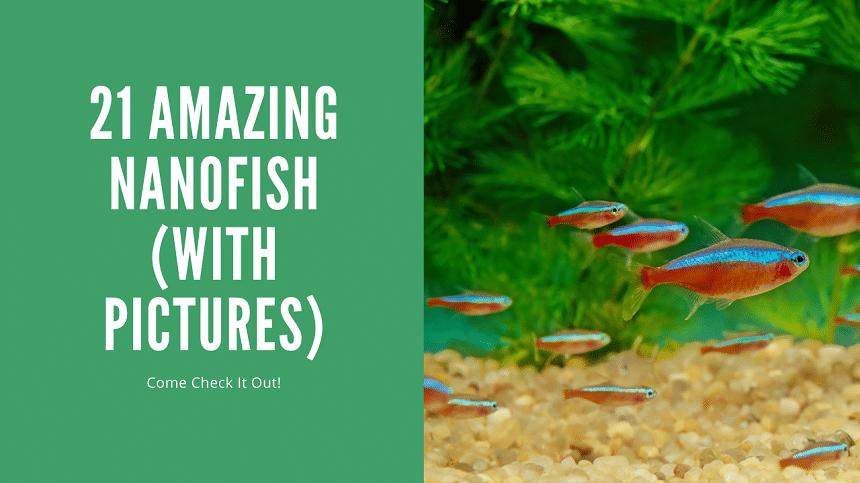Thank you for visiting! By the way… any links on this page that lead to products on Amazon and other stores/partners are affiliate links Aquarium Store Depot earns a commission if you make a purchase.
One of the most popular trends in the modern fishkeeping hobby is nano fish and nano aquariums. It might sound more like robotics than aquatics, but the term nano really refers to miniature fishkeeping in small aquariums.
This is a really fascinating side of the hobby and something that all aquarists should try. In this article, I’ll provide you with all the basics you need to know about nano fishkeeping and introduce 21 amazing nano fish for your home aquarium.
Going Nano
The most obvious reason to get into nano aquariums is to save on space. Once the aquarium ‘bug’ bites, a lot of us want just one more tank. Aquariums are big, heavy, and can be expensive, but they don’t have to be. Welcome to the world of nano aquariums!
In the aquarium hobby, nano simply means small. There aren’t really any strict rules about what counts as nano and what doesn’t, but generally, a nano species is one that grows about 2 inches or less in length. Nano tanks would be about 20 gallons or less, but again, just think of the word nano as meaning small.
A common misconception about nano tanks, however, is that they are easier to maintain than larger aquariums. Actually, keeping small tanks with miniature fish can be a very interesting and hands-on hobby. This is because the smaller the aquarium the more sensitive the system will be to changes in water quality.
21 Best Nano Fish For Your Freshwater Tank
Of course, not all fish that are 2 inches or less make great aquarium subjects, so I’ve put together a list of 21 awesome nano fish to get you started. All these fish do really well in nano tanks and are pretty easy to find. For each species, I’ll provide a basic description and some important information like:
- Scientific Name
- Adult Size
- Care Level
- Temperament
- Minimum Tank Size
- Diet
- Origin
- Temperature
- Swimming Level
We have a video below from our YouTube channel. We go into greater detail in the blog post below. If you like our video content, please give us a like and subscribe. We post every week!
So let’s jump right in and get to know the stars of the nano world!
1. Neon Tetra
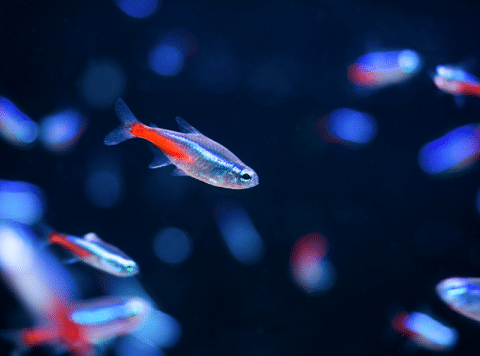
- Scientific Name: Paracheirodon innesi
- Adult Size: 1.5 inches
- Care Level: Easy
- Temperament: Peaceful
- Minimum Tank Size: 10 gallons
- Diet: Carnivorous, feed granules or flakes, live and frozen foods
- Origin: South America, Brazil, Peru, Colombia
- Temperature: 70-74°F
- Swimming Level: Midwater
You only have to take a look at the stunning Neon Tetra to understand why they are one of the most popular freshwater fish for nano tanks. These stunning South American fish are easy to feed and care for, even if you are a beginner.
Neon Tetras are peaceful fish that work great in community tanks with aquatic plants. Neons are social little fish, so be sure to keep a group of at least 5 or 6 to keep them happy and confident.
2. Ember Tetra

- Scientific Name: Hyphessobrycon amandae
- Adult Size: 0.8 inches
- Care Level: Easy
- Temperament: Peaceful
- Minimum Tank Size: 10 gallons
- Diet: Carnivorous, feed granules or flakes, live and frozen foods
- Origin: South America, Brazil
- Temperature: 70-74°F
- Swimming Level: Midwater
Ember Tetras are active and colorful little shoaling fish that look especially good in planted aquariums. They are great fun to watch as they swim around actively in the nano aquarium. These beginner fish are very peaceful, making them a perfect addition to community tanks.
3. Harlequin Rasbora
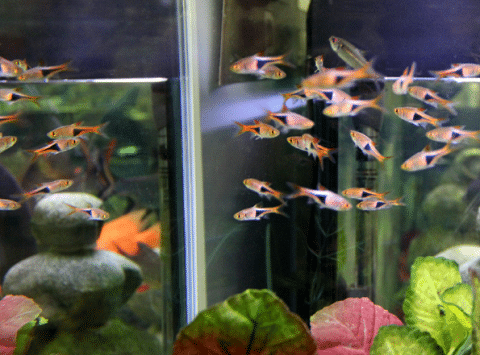
- Scientific Name: Rasbora heteromorpha
- Adult Size: 1.75 inches
- Care Level: Easy
- Temperament: Peaceful
- Minimum Tank Size: 10 gallons
- Diet: Omnivorous, feed granules or flakes, live and frozen food
- Origin: Asia, Thailand, Singapore, Malaysia
- Temperature: 70-74°F
- Swimming Level: Midwater, Top
Harlequin Rasboras are neat little shoaling fish for nano tanks. The bold black triangular marking and golden orange colors of these fish look amazing as they move around together. The Harlequin Rasbora is a schooling fish that prefer to be in groups, so keep ten or more if possible.
4. Cardinal Tetra
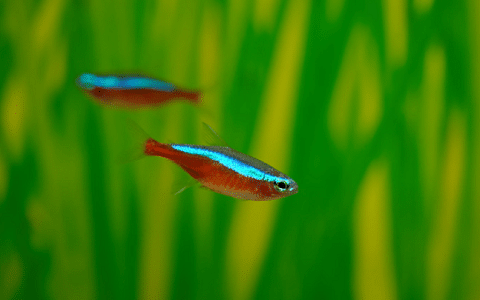
- Scientific Name: Paracheirodon axelrodi
- Adult Size: 1.5 inches
- Care Level: Easy
- Temperament: Peaceful
- Minimum Tank Size: 15+ gallons
- Diet: Carnivorous, feed granules or flakes, live and frozen food
- Origin: South America, Brazil
- Temperature: 74-78°F
- Swimming Level: Midwater, Top
The Cardinal Tetra is another great tiny fish for nano tanks. They are often confused with their smaller neon cousins, although cardinals have a lot more red coloration on their sides. A beautiful crimson shade extends from their tails all the way to their gills.
Cardinal Tetras contrast incredibly in heavily planted natural aquariums and get along perfectly with other small and peaceful tankmates in nano aquariums.
5. Pygmy Corydoras
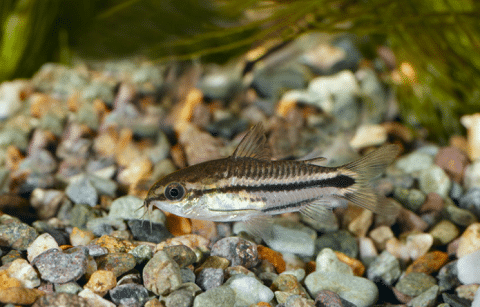
- Scientific Name: Corydoras pygmaeus
- Adult Size: 1 inch
- Care Level: Easy
- Temperament: Peaceful
- Minimum Tank Size: 10+ gallons
- Diet: Omnivorous, feed pellets, wafers, frozen and live foods.
- Origin: South America, Brazil
- Temperature: 70-74°F
- Swimming Level: Bottom
Pygmy Corydoras are great little nano catfish. Like other schooling fish, they should be kept in groups of 6 individuals or more so that they can display all of their natural social behaviors in the nano aquarium.
Although these little catfish spend most of their time at the bottom of the nano tank, they will also swim around in the midwater, even making occasional trips up to the surface of the water. Cory cats feed by sifting through the substrate, so use sand instead of any sharp gravel that might hurt them.
6. Longfin White Cloud Minnow
- Scientific Name: Tanichthys albonubes
- Adult Size: 1.5 inches
- Care Level: Easy
- Temperament: Peaceful
- Minimum Tank Size: 10 gallons
- Diet: Carnivorous, feed granules or flakes, live and frozen foods
- Origin: Asia, China, Vietnam
- Temperature: 70-74°F
- Swimming Level: Midwater
The Longfin White Cloud Minnow is an even more attractive version of a classic aquarium species. These colorful little fish come from an area known as the white cloud mountain and do best in cooler water than your typical tropical aquarium fish. These fish should be kept in groups of ten or more to really enjoy all they have to offer.
7. Cherry Barb
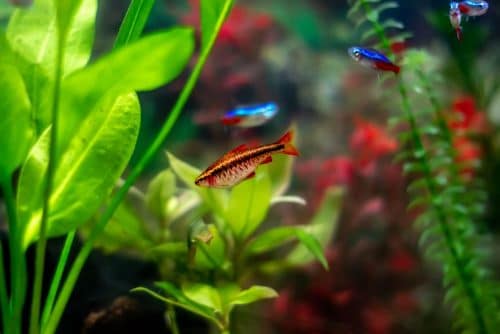
- Scientific Name: Puntius titteya
- Adult Size: 2 inches
- Care Level: Easy
- Temperament: Peaceful
- Minimum Tank Size: 20 gallons
- Diet: Omnivorous, feed, live, frozen, and dried foods
- Origin: Asia, Sri Lanka
- Temperature: 70-74°F
- Swimming Level: Midwater
Although Cherry Barbs are classified as a nano species, they do need a tank of about 20 gallons or more to be at their happiest. Both the males and females have beautiful orange colors, but the males are definitely the more colorful ones, especially when breeding. It is best to keep these barb fish in groups of 6 or more and in a ratio of one male to two females.
8. Spotted Rasbora
- Scientific Name: Boraras maculatus
- Adult Size: 1 inch
- Care Level: Moderate
- Temperament: Peaceful
- Minimum Tank Size: 10 gallons
- Diet: Carnivorous, feed live or frozen foods and granules
- Origin: Asia, Malaysia, Indonesia
- Temperature: 70-74°F
- Swimming Level: Midwater, Top
Spotted Rasboras are true nanos (video source). These slim little shoaling fish reach about an inch in length and are some of the smallest freshwater fish in the hobby. Although they are fairly easy to care for, they are shy by nature so keep them only with very calm and peaceful fish, or even better, in large groups with inverts.
9. Gold White Cloud Minnow
- Scientific Name: Tanichthys albonubes
- Adult Size: 1.5 inches
- Care Level: Easy
- Temperament: Peaceful
- Minimum Tank Size: 10 gallon
- Diet: Live, frozen, and dried foods
- Origin: Asia, China
- Temperature: 70-74°F
- Swimming Level: Midwater
Gold white clouds are a familiar favorite with even more color than the regular species (video source). These beginner fish get their name from the white cloud mountain region where they were first found in the wild.
They are shoaling fish that should be kept in cool water tanks, and often do best without heating. These peaceful fish prefer to live in groups of ten or more, although a group of six will also work in a smaller nano aquarium.
10. Bumblebee Platy
- Scientific Name: Xiphophorus maculatus
- Adult Size: 2-3 inches
- Care Level: Easy
- Temperament: Peaceful
- Minimum Tank Size: 15 gallons
- Diet: Frozen, live, or dried foods
- Origin: North and South America, Mexico, Nicaragua, Guatemala, and Belize
- Temperature: 72-80°F
- Swimming Level: Midwater
Bumblebee Platys get their name from their boldly contrasting black and yellow markings (video source). They are a great beginner community species for home aquariums.
Keeping more females than males is generally advised. This gives the females a break from the males’ attention. These fish are livebearers, so you can expect plenty of fry if your fish are happy and healthy.
11. Celestial Pearl Danio
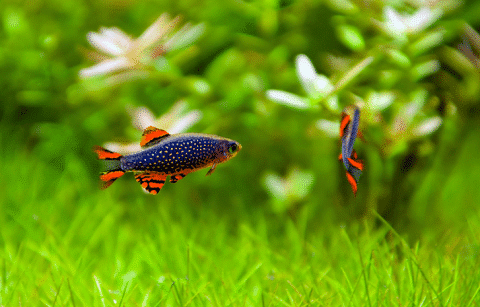
- Scientific Name: Celestichthys margaritatus
- Adult Size: 0.75 inches
- Care Level: Moderate
- Temperament: Peaceful
- Minimum Tank Size: 10 gallons
- Diet: Omnivorous, feed dried, frozen, and live foods
- Origin: Asia, Myanmar, Thailand
- Temperature: 70-74°F
- Swimming Level: Midwater
Celestial Pearl Danios are often known as CPDs or the Galaxy Rasbora. The popularity of Celestial Pearl Danios is no surprise because they are some of the most stunning nano fish available in the aquarium trade.
The male fish have bolder markings than the female, but both sexes are really pretty. Celestial Pearl Danios are the perfect species for heavily planted nano tanks.
12. Chili Rasbora
- Scientific Name: Boraras brigittae
- Adult Size: 0.8 inches
- Care Level: Easy
- Temperament: Peaceful
- Minimum Tank Size: 5+ gallons
- Diet: Carnivorous, feed live, frozen, and dried foods
- Origin: Asia, Borneo
- Temperature: 70-74°F
- Swimming Level: Midwater, Top
The Chili Rasbora, Boraras brigittae, is a colorful and active micro Rasbora species that grows to less than an inch in length. This makes them perfect for smaller tanks with shrimp (video source).
They should be kept in groups of at least 6, although a larger tank with an even larger school is a great option too. Chilli Rasboras will feel most at home and look their best in a soft water tank with plenty of aquatic plants.
13. Red Pencil Fish
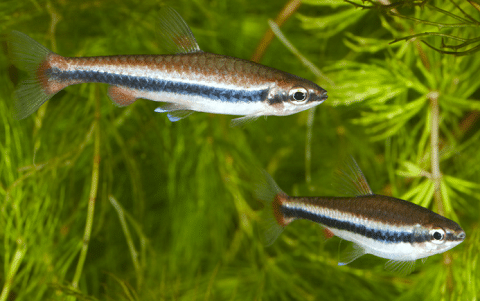
- Scientific Name: Nannostomus beckfordi
- Adult Size: 1.4 inches
- Care Level: Moderate
- Temperament: Peaceful
- Minimum Tank Size: 10 gallons
- Diet: carnivorous, Feed live, frozen, and dried foods
- Origin: South America, Brazil, Venezuela, Guyana, Suriname, and French Guiana
- Temperature: 70-74°F
- Swimming Level: Midwater, top
Red Pencil Fish are peaceful community fish that look and feel their best in a nano tank with plenty of live plants and hardscapes like driftwood and rocks. This species of small freshwater fish do great in community aquariums, as long as its nano tank mates are also peaceful and not too big.
14. Black Neon Tetra

- Scientific Name: Hyphessobrycon herbertaxelrodi
- Adult Size: 1.5 inches
- Difficulty Level: Easy
- Temperament: Peaceful
- Minimum Tank Size: 20 gallons
- Diet: Omnivorous, feed, live, frozen, and dried foods
- Origin: South America, Brazil
- Temperature: 70-74°F
- Swimming Level: Midwater
Black Neon Tetras are hardy freshwater shoaling fish that are a great beginner species. If you’re looking for something a little different from the more popular neons and cardinals, this could be just the fish for you. They are a little larger than some other tetras though, so they should be kept in tank sizes of about 20 gallons or more. On average, Black Neons are hardier than Neons and Cardinal tetras.
15. Siamese Algae Eater

- Scientific Name: Crossocheilus oblongus
- Adult Size: 7 inches
- Difficulty Level: Easy
- Temperament: Peaceful
- Minimum Tank Size: 40 gallons
- Diet: Herbivorous, feed pellets and wafers
- Origin: Asia, Malaysia, Thailand
- Temperature: 61-75°F
- Swimming Level: Bottom
The Siamese Algae Eater (SAE) is a great little species that is very useful in the aquarium. They eat algae, which can really help to keep your aquarium looking great.
Of course, this doesn’t mean you don’t have to feed them regularly as well. SAEs grow to over 6 inches in length, so they do need at least a 40-gallon aquarium to thrive. Not exactly a nano fish, but they work really well in planted tanks.
16. Clown Killifish
- Scientific Name: Epiplatys annulatus
- Adult Size: 1.5 inches
- Difficulty Level: Moderate
- Temperament: Peaceful
- Minimum Tank Size: 5 gallons
- Diet: Carnivorous, feed live and frozen foods
- Origin: Africa, Sierra Leone, Guinea, Liberia
- Temperature: 68-79°F
- Swimming Level: Top
If you want a great-looking species of fish for the top water levels of your nano aquarium, the Clown Killifish is a great option (video source). These tiny fish are little predators that like to look for tiny insects on the surface of the water. Clown killifish prefer calm water conditions and should be fed small animal foods like baby brine shrimp.
17. Glolight Danio
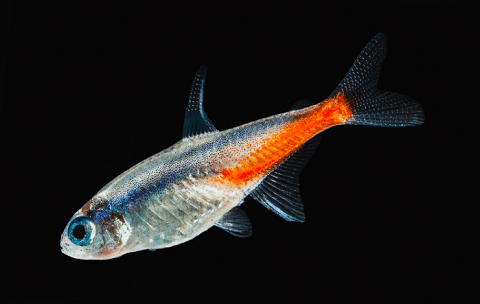
- Scientific Name: Celestichthys choprae
- Adult Size: 1.5 inches
- Difficulty Level: Easy
- Temperament: Peaceful
- Minimum Tank Size: 15 gallons
- Diet: Carnivorous, feed live, frozen, and dried foods
- Origin: Asia, Myanmar
- Temperature: 72-80°F
- Swimming Level: Midwater
Glolight Danios are gorgeous little fish for nano tanks, with all-natural colors. This relative of the Celestial Pearl Danio is pretty new to the hobby but has really grown in popularity.
They are an active species that like to be kept in groups of at least 6. Keep these small danio fish in a tank with lots of plants and a dark substrate to really bring out their colors.
18. Panda Cory
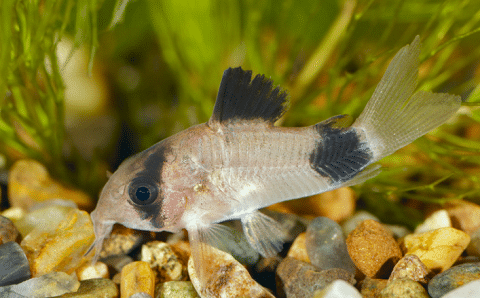
- Scientific Name: Corydoras panda
- Adult Size: 2 inches
- Difficulty Level: Easy
- Temperament: Peaceful
- Minimum Tank Size: 15 gallons
- Diet: Omnivorous, feed live, frozen, and dried pellets/tablets
- Origin: South America, Peru
- Temperature: 70-74°F
- Swimming Level: Bottom
Panda Corys are very distinctive little catfish with their bold black and silvery markings. These active little bottom feeders should be kept in groups so that you can watch them explore the nano tank together with confidence. Panda Corys are very peaceful creatures that work well in community tanks.
19. Dwarf Honey Red Gourami
- Scientific Name: Trichogaster chuna/ Colisa chuna
- Adult Size: 2 inches
- Difficulty Level: Moderate
- Temperament: Semi-aggressive when breeding
- Minimum Tank Size: 15 gallons
- Diet: Carnivorous, feed frozen, live, or dried foods
- Origin: Asia, India, Bangladesh, Nepal
- Temperature: 72-80°F
- Swimming Level: Midwater
The Dwarf Honey Red Gourami is an excellent freshwater fish species with some really fascinating behaviors. These labyrinth fish breathe air from the water surface and they are foam nesters. Dwarf Honey Red Gouramis are great in community tanks if they are kept with other small, peaceful species.
20. Betta Fish
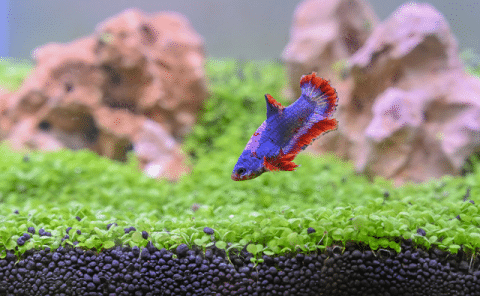
- Scientific Name: Betta splendens
- Adult Size: 2.5 inches
- Difficulty Level: Moderate
- Temperament: Aggressive
- Tank Size: 5+ gallons
- Diet: Carnivorous
- Origin: Asia, Thailand, Cambodia, Vietnam
- Temperature: 74-79°F
- Swimming Level: Midwater
It’s not difficult to see why Betta fish are some of the most popular aquarium fish of all time. These small freshwater fish look amazing and have heaps of personality, making them really great pets. Caring for Betta fish is not as easy as many people think, so be sure to do your homework before bringing one home. Male bettas also have special consideration for tank mates since they are territorial and will fight with other males.
21. Otocinclus Catfish

- Scientific Name: Otocinclus spp.
- Adult Size: 2 inches
- Difficulty Level: Easy
- Temperament: Peaceful
- Tank Size: 10+ gallons
- Diet: Algae eaters, feed wafers and vegetables like zucchini
- Origin: South America, Argentina, Venezuela
- Temperature: 70-74°F
- Swimming Level: Bottom, midwater, top
Otocinclus are probably the best algae-eating fish species for small tanks. Their vegetarian diet means they can be kept safely with even the smallest shrimp.
Otos spend a lot of the time grazing on algae on the walls of the aquarium and other surfaces like driftwood and leaves. They can be very active though and enjoy swimming around at speed in groups of at least 6.
How To Set Up Your Tank
If there’s a specific type of fish that has caught your eye, it is best to set up your tank to suit the needs of the species. The minimum tank sizes listed for freshwater fish species are a good guideline, but if you have the space, choose a tank a little larger to make sure they will be comfortable in their new home.
Filtration
Good filtration is vitally important for maintaining a healthy environment for the freshwater fish in your nano tank. The general rule is to opt for a filter model that can process the total water volume 4-6 times every hour. For smaller tanks, a power filter may make more sense. When using nano fish in a planted tank or aquascape, a canister filter is a good option to handle the added bioload of plant waste.
Some species, like Betta fish for example, really don’t enjoy a strong current in small tank sizes so you might want to look at directing the filter’s outflow in a way that breaks up the water flow, use an air-powered filter like a sponge filter. You can also put a sponge on the intake to keep the fish’s long fins from getting caught.
The Nitrogen Cycle
One of the most difficult concepts for beginner aquarists is the nitrogen cycle. There are loads of great resources out there to help you understand this process in-depth, but I’ll give you a quick run-down of the basics here.
A chemical known as ammonia is released into the water in fish waste and uneaten fish food. Before this chemical can be made safe for your fish, it has to go through two changes.
First, it is changed into a substance known as nitrite (still dangerous) and finally into nitrate (safe). These changes are made by special bacteria that naturally colonize your tank and your filter.
The process of building up colonies of these helpful bacteria takes a little while, and that’s why you need to cycle your tank for a month or so before introducing your first new fish.
Water Quality
Having a good quality filter set up and let your tank cycle fully are the first steps towards maintaining great water conditions in your nano freshwater aquarium. You’ll also need to perform a regular partial water change because the nitrogen cycle and your filter alone often can’t manage all the waste and uneaten food in your fish tank.
Make sure you use a water conditioner in the new water you’re putting into your aquarium. Some important tips for keeping your water quality high are to make sure to stock your nano tanks appropriately and to be careful not to overfeed your fish.
Growing live plants can also help to maintain good water quality. Many freshwater plants are really good at absorbing excess nutrients which can really help to maintain good water conditions.
Substrates
If you’re keeping an unplanted fish tank, your choice of substrate will mostly come down to what looks best to your eye. Often, darker colored substrates make the beautiful bright colors of freshwater fish like Neon Tetras really pop.
If you plan on setting up a planted tank, you may as well start out with a great aquarium soil like Fluval Stratum. If you’ve already set up your nano tank with gravel or sand, don’t worry, root-feeding aquarium plants can still be fed with root tabs.
One specific point to note is that the cories, which are really popular fish, should not be kept over sharp gravel, and they prefer a sand substrate. This is because they like to dig through the sand to look for food, and sharp edges can really damage their mouths.
Hiding Places
Providing plenty of hiding places in your nano tank can often help to keep your fish more confident and healthy. Live plants work for this, or you can make a cave with driftwood or rocks.
An easy alternative is to use a fish-safe aquarium cave ornament. Hiding places gives any fish that are being bullied or harassed a place to rest, and also keeps fry and baby shrimp safe from hungry fish.
The Planted Aquarium
Freshwater nano fish are probably the best tank mates for aquarium plants because they don’t do any harm to the plants, and many of these little fish just love swimming through and hiding amongst live plants. Some great plant species for nano tanks include:
Check out some of my growing guides in the links above for more great information.
Biotopes
Creating a biotype is really just the process of trying to recreate the natural look and feel of the environment where your fish naturally originate. A great biotope would be a community tank with live plants and species of fish that occur together in nature. For example, an Amazon river basin biotope could have fish like tetras, pencilfish, and corydoras, with plants like Amazon Sword.
Where To Buy
The freshwater nano fish in this list are all very popular and most can be found at your local fish store. Nano species can be pretty fragile little creatures, so I recommend a trusted online retailer.
FAQs
How many fish can be in a small tank?
The number of fish you can keep in nano tanks will depend on the quality of your filtration, and of course the size and number of fish. Some species need a lot more space than others, for various reasons. It is always better to make sure your fish are happy and healthy rather than to try to fit as many fish as possible into the aquarium.
What do you feed them?
One of the challenges when it comes to keeping nano species is providing them with the right food. Small fish have small mouths, so dried foods often need to be ground down to a smaller size. You can do this by simply crushing flake foods and pellets, or even using something like a pepper grinder.
Feeding frozen or live foods like micro-worms and newly hatched brine shrimp are also essential for keeping your omnivorous or carnivorous fish healthy and looking great.
Do these tanks need filters?
Good filtration is really important for maintaining good water quality in nano tanks. Unfortunately, some sellers claim that some fish like bettas don’t need filters. Filtration will greatly improve the lifespan and quality of life of your pets.
What is a nano aquarium?
Nano tanks are small aquariums. There isn’t really a universally agreed size limit, but you could consider anything below a 20-gallon tank to be nano.
What does nano stand for?
In the aquarium world, nano simply means small. Folks may argue about the actual cut-off lines of what’s nano and what isn’t, but as a general rule, think of any micro fish with an adult length of under 2 inches as a nano species.
Closing thoughts
Does the world of nano aquariums sound interesting to you? If so, any of the 21 amazing fish species in this list would look great in your own nano aquarium. The possibilities are really endless once you begin to explore the world of miniature fishkeeping. Please comment below if you have any questions. Happy fishkeeping!
- About the Author
- Latest Posts
I’m thrilled that you found Aquarium Store Depot! Here you’ll find information on fish, aquariums, and all things aquatics related. I’m a hobbyist (being doing this since I was 11) and here to help other hobbyists thrive with their aquariums! I adhere to a high quality Editorial Process and Review products with real life field usage and practical analysis.

